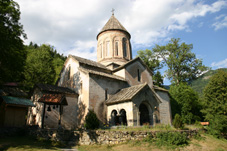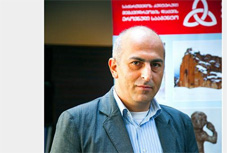Across Georgia, cultural heritage is in danger under Patriarchate’s arbitrary power
By Levan Abramishvili
Wednesday, August 21



“It’s a small, movable wardrobe, where we, the perish, keep our coats. Unfortunately, in Georgia, people fighting against the church will use any lie to convince people that terrible things are happening in the church,” said a member of the Timotesubani church parish. However, in the photos that were posted on social media, it is easily recognizable that the wardrobe is installed in the wall of the church.
This comes after the clerics in the central church of Kintsvisi monastery complex tiled the floor of the 13th century church, completely disregarding the state institutions and the law protecting the monument.
In both instances, which happened just a week apart, it was the civil society that informed the National Agency for Cultural Heritage Preservation about the violations of the law. Later it was explained that the Agency arrived in Kintsvisi, however, they didn’t call the police “out of respect of the clerics there”.
Both the State agencies and the Georgian Patriarchate were uninformed about the ongoing renovation processes in the churches that have cultural significance for the country and the world.
Later on it was announced by the head of the National Agency for Cultural Heritage Preservation Nikoloz Antidze that a meeting was held with the representatives of the church. It was agreed that an installation of a new wardrobe that would be compatible with the interior of the church was possible.
“The monastery is functioning and every monastery needs some kind of a storage space in the church. Therefore, we asked our specialists to prepare an appropriate project that would arrange a wardrobe that would be functional for the church and would not damage the appearance of the monument. It is good that the Church has declared that they are ready for cooperation. As I know it was a very constructive and productive meeting. The specialists have not returned yet. I will have detailed information upon their arrival,” Nikoloz Antidze told Radio Liberty.
Georgia has a solid legal foundation for the protection of the cultural heritage monuments. The 61-article law describes in detail all the activities that are allowed to be conducted in the churches, which, not surprisingly, does not include uninformed tiling and installing of wardrobes in the monuments.
As most of the cultural heritage monuments are within the responsibility of the Apostolic Autocephalous Orthodox Church of Georgia, it is their duty to control their clerics to not conduct illegal activities in such important monuments. Yet, despite having all the resources to do so, the Patriarchate lacks willingness to help the Georgian State enforce the law.
From 2002 to 2016, the religious organization received a total of GEL 226 million from the central state budget. From 2009 to 2013, the annual allocations ranged from 22 million to 27 million, and since 2013, the state budget has steadily allocated 25 million for funding the church.
Aside from the 25 million, the Orthodox Church receives countless real estate and land plots for free. For example, according to the Tolerance and Diversity Institute, in 2016, the Orthodox Church was given 20 plots of land with a total area of 287,222 square meters; while in 2015, they received 21 plots of land, 568,060 square meters total. The Church also receives money from the reserve fund, Prime Minister’s fund and other governmental sources.
With 25 million yearly, it shouldn’t be hard to allocate some money to make sure that the clerics that carry out religious activities in the monuments of cultural heritage don’t violate the State law. But, as many other things in Georgia, it is left upon the civil society to control the wrongdoings of the Church.
The Constitutional Agreement between the Georgian state and the Apostolic Autocephalous Orthodox Church of Georgia (Concordat), ratified in 2002, regulates the relationship between the two and recognizes the special role of the Church in the history of Georgia.
